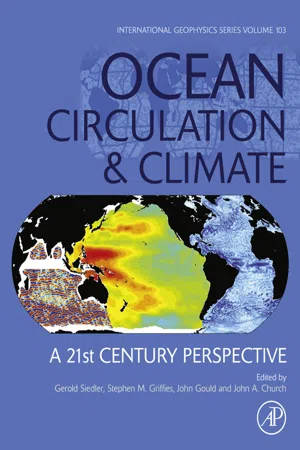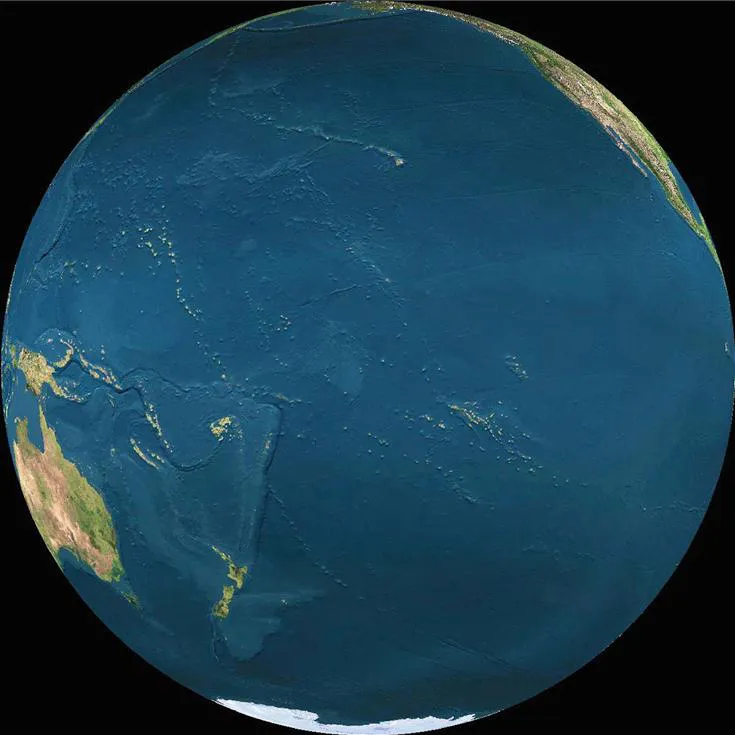![]()
Part I: The Ocean’s Role in the Climate System
Outline
Part I: The Ocean's Role in the Climate System
Chapter 1 The Ocean as a Component of the Climate System
Chapter 2 Paleoclimatic Ocean Circulation and Sea-Level Changes
![]()
Part I: The Ocean's Role in the Climate System
This book is concerned with the role of the ocean in the climate system, with a focus on physical processes relevant to scientifically describing and understanding that role. The two chapters in this Part I offer a context for the discussion extending over the nearly 30 chapters that follow. We are introduced in this Part to notions of the huge space and time scales over which ocean phenomena play a role in climate. Such phenomena extend from the millimeter and seconds relevant for irreversibly mixing heat, carbon, and other tracers, to the global scales of sea level changes, water mass variations, and air–sea interactions that comprise natural and anthropogenic climate fluctuations. We also encounter evidence seen for rather large fluctuations in the paleo record, and consider future climate scenarios suggested through computer simulations.
The ocean is often termed the flywheel of the climate system. This metaphor has relevance given that roughly 3 m of the ocean contains heat equivalent to the entire atmosphere. Furthermore, the ocean absorbs the relatively rapid synoptic atmospheric fluctuations in a way that provides a low pass filter to the climate system, and in so doing reflects the vast thermal inertia available in the ocean. Furthermore, the ocean transfers mechanical energy across space and time scales, thus adding both richness and complexity to ocean phenomena. These properties form part of the foundation for how the ocean interacts with other components of the earth climate system.
As oceanographers explore the ocean through theory, observations, and simulations, they continue to solidify the perspective that nearly all ocean phenomena play some role in climate. For example, climate scientists as recently as the early 1990s discounted the role of astronomical ocean tides, assuming they merely add a few harmonic wiggles to measurements yet have no major impact on climate. However, research on the role of tides and ocean mixing, and the associated role of ocean mixing on climate, provide striking evidence for the basic connection between tides and climate. Other examples can be identified where developing a fundamental understanding of ocean processes is prerequisite to establishing a deeper and more predictive description of climate. This theme forms part of the mandate for this book.
Science generally evolves through methodical additions to previous theories and observations, as well as through the somewhat chaotic paradigm shifts arrived at through new insights, data, and perspectives. Oceanography and climate science have seen their share of such evolutionary steps, with examples provided in the two chapters of this Part as well as others exhibited throughout this book. We trust that this Part will whet the appetite for readers as they further explore elements of how the ocean forms a fundamental component of the earth’s climate system.
![]()
Chapter 1
The Ocean as a Component of the Climate System
Thomas F. Stocker, Physics Institute, University of Bern, Bern, Switzerland
Abstract
A broad perspective of the ocean as a key component of the Earth System and of its role in the past, present, and future climate change is provided. The ocean is a huge reservoir of heat, mass, carbon, and many other quantities, and their estimated exchange fluxes suggest characteristic timescales of adjustment ranging from decades to many thousands of years. Surface patterns and meridional fluxes of these quantities highlight the important role of the wind-driven circulation and the deep ocean flow systems through all ocean basins. Ocean-dominated phenomena of natural variability, in particular associated with the tropical oceans, are explained. The relevance of the ocean circulation for abrupt climate change, as recorded from a variety of paleoclimate records, is discussed. This includes the bipolar seesaw concept which explains many features of interhemispheric response during the sequence of rapid warmings in the past ice age. Finally, the ocean’s role during the anthropocene, the time epoch which is dominated by the human-caused increase in greenhouse gases to levels unprecedented in the past 800,000 years, is explored. Both the warming and the increase in atmospheric transport of water polewards create conditions for the ocean that may induce large and irreversible changes in the Atlantic meridional overturning circulation.
Keywords
Ocean; Climate; General ocean circulation; Meridional fluxes; Air–sea fluxes; Past circulation; Future circulation; Bipolar seesaw
1 Setting the Scene
From certain points of view, the Earth appears as an almost perfect “aquaplanet” (Figure 1.1). This is a powerful visual testimony to the importance and key role of the ocean in the Earth's climate system. More than 70% of the entire Earth surface is covered by the ocean and therefore most of the lower boundary of the atmosphere is in contact with water or, in the high latitudes, with the seasonal sea ice cover.
Figure 1.1 Ocean appearance of the Earth in an idealized cloud-free view constructed using Earth viewer (from 35,785 km above 10 °S, 160 °W).
The ocean constitutes a virtually unlimited reservoir of water for the atmosphere because it is by many orders of magnitude the largest body of readily accessible water on Earth. Water is the principal resource of all life and thus represents a global commons. A quantitative understanding of the world ocean must therefore be a top priority of Earth System science. Such an understanding rests on three pillars: (i) in situ and remote observations with worldwide coverage; (ii) theoretical understanding of processes within the ocean and at its boundaries to other Earth System components; and (iii) capability of simulating ocean and climate processes in the past, present, and future, using a hierarchy of physical–biogeochemical models. Each of these pillars are considered in Section 2, Sections 3 and 4, and Chapter 2, and Sections 5 and 6, respectively.
Due to its large spatial extent and as the principal water reservoir on Earth, the ocean supplies more than 80% of the water vapor for the atmosphere. When the mean atmospheric temperature is higher, the atmosphere contains more water vapor, which is drawn primarily from the ocean. In times of a colder atmosphere that water is returned to the ocean, or when the climate is significantly colder as during an ice age, a significant amount of water is transferred from the ocean to the large ice sheets on land. The ocean is thus the dominant source of the Earth's most important greenhouse gas, water vapor, which is primarily responsible for increasing the Earth's mean surface temperature by about 33 °C to its present value of about 15 °C. Therefore, the ocean is an essential component for habitability of the Earth.
The climate system can be usefully partitioned into seven spheres which are physically coupled through exchange fluxes of energy, momentum, and matter. This is schematically illustrated in Figure 1.2. The notion sphere should not suggest that the Earth System components are separate entities, they are intertwined. This is, for example, evident for the hydrosphere which is present throughout the Earth System. The ocean as the major part of the Earth's hydrosphere interacts with all components of the Earth System. It is also coupled to biogeochemical processes through exchange fluxes of substances such as carbon, nitrogen, and many others. Hence, the Earth System cannot be understood without detailed quantitative knowledge of the ocean, its physical properties and the various processes that determine its status and its response to forcings and perturbations.
Figure 1.2 Illustration of the seven spheres of the Earth System, which are intertwined and physically coupled through exchange fluxes of energy, momentum, and matter, and biogeochemically coupled through fluxes of carbon and other substances.
The ocean is coupled to the atmosphere through exchanges of momentum, heat, water, and many substances such as oxygen, carbon dioxide, and other trace gases, and minerals in the form of dust and suspended solids. The exchange of momentum, mediated by the action of wind systems, is the primary driver of the ocean circulation, but also fluxes of heat and freshwater, which influence the density of ocean water and its regional distribution, are important in determining the properties and the flow of water masses.
The cryosphere comprises the terrestrial ice sheets, glaciers, and sea ice, and these interact with the ocean directly and indirectly, both through the freshwater supply to the ocean and its effect on sea level (Chapter 27), and through the modification of the ocean–atmosphere heat exchange in the case of sea ice cover (Chapter 16). The ocean is also influenced by the terrestrial and marine biosphere, mainly through biogeochemical coupling via fluxes of carbon, oxygen, and nutrients. The pedosphere, that is, the land surface, directs river runoff and therefore the spatial distribution of freshwater delivery to the ocean, which modifies water mass properties and ocean circulation. The lithosphere comprises the solid Earth which supplies minerals through, for example, volcanism and weathering, and is responsible for processes that influence the geochemistry of the climate system. It is a component that is relevant when Earth System processes on time scales of 105 years and longer are studied.
The latter part of the eighteenth century marks the beginning of the industrial use of coal, and therefore a seventh sphere has started to become important in the Earth System. It is the anthroposphere, indicated in Figure 1.2, which comprises all human activities, for example, emissions of greenhouse gases through the burning of fossil fuels, land use change, particularly deforestation, and the input of dust and chemical constituents into the various spheres. Further, anthropogenic land surface changes also impact physical properties such as albedo, surface roughness, and regional water and heat balances. Human activities have become important drivers of climate and environmental change, and we now live in an epoch in which we leave traces and imprints that will be detectable by our successors using today's classical analytical methods many centuries and millennia from now. It is thus appropriate to put this epoch into a longer-term context of geological epochs by naming it Anthropocene, as proposed by Crutzen and Stoermer (2000). Therefore, understanding of the anthroposphere and its influence on all the other Earth System spheres is an important prerequisite for assessing the future evolution of the Earth's spheres on a human time scale and thereby for a responsible stewardship of our only home.
2 The Ocean as an Exchanging Earth System Reservoir
The ocean covers about 71% of the Earth surface and has a mean depth of 3734 m (Talley et al., 2011) as estimated from the most recent geodetic data analysis (Becker et al., 2009). The ocean volume is about 1.34 × 1018 m3 and thus contains more than 95% of the Earth...


